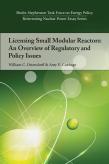The energy landscape in the United States has been reshaped since the development of our commercial nuclear power fleet. Innovations in horizontal drilling and hydraulic fracturing of shale source rock have made this country “the Saudi Arabia of natural gas” by reimagining the production of resources once thought unexploitable. Wind and solar power dot the landscape, driven by supporting policy but also by continuous advances in technological performance, manufacturing, and business strategy. They have evolved from science experiments to now justifying their own roles on our changing electric grids. Meanwhile, rethinking how we use our energy, from LED lighting to low-heat-loss windows, has dramatically improved efficiency and disrupted the curve on national electricity demand. Over the past decades, nuclear power has been an affordable, reliable, and low-polluting pillar of our energy system; as we look to the future, can it too be reinvented to sustain and enhance the nuclear contribution in a newly diverse and robust energy industrial landscape?
Our purpose in the Shultz-Stephenson Task Force on Energy Policy's Reinventing Nuclear Power project is to offer a technically grounded and policy-informed assessment of the case for a US civilian nuclear future in a modernizing grid. To do this, we have asked experts from around the country to use a fresh mind to identify the largest obstacles to shaping national energy policies in this area and the decision points around them, to specify potential roles for government, military, and the private sector, and finally, to propose solutions in defining a way forward.
To begin, we are focusing on one new and thought-provoking approach to nuclear power: small modular reactors (SMRs), a number of designs for which have been created over the last decade. These concepts, some scaled down versions of existing plants and some employing new technologies, are intended to produce advantages in scale, cost, safety, distributed power, security, and industrial base expansion while also bringing the historic benefits of commercial nuclear power: emissions-free base load generation, power source diversity, and energy security. At the same time, however, progress toward licensing, production, and employment of this technology has been slow and potential commercial introduction remains years away.
To that end, the following areas merit consideration:
Need: In light of America's energy transformations, especially natural gas's increased use in power generation, is there still a business case for SMRs? What are the emissions implications of, on the one hand, coal-fired electric generating plants being replaced while, on the other hand, older conventional nuclear plants are closed or age out in large numbers in the two decades ahead? And how might SMRs fit into the potential security implications of a grid with an otherwise declining share of long-lived, fuel delivery-secure, base load capacity?
Regulation: The impact of regulation on the nuclear industry is significant. While essential to ensuring public safety, the processes led by the Nuclear Regulatory Commission (NRC) which guide the design certification, site approval, granting of a combined construction permit and operating license, and oversight of operations are complex, laborious, lengthy, and expensive. Application of NRC oversight to SMR designs and operation will unavoidably shape the business case and determine to a significant degree the practicality of the SMR concept.
Potential SMR Customers: In the United States, economic market forces are preferred to long-term government subsidies. In the regulated market, SMR construction and operation must pass the review of states' public utility commissions in order to allow pass-through costs. In the unregulated market, they must compete with low cost gas generation. What is the future of the commercial nuclear enterprise in the United States in general, and for SMRs, specifically?
Industrial Base: An oft-stated justification for advancing a program of SMRs is to retain or revitalize the industrial base. Components for the current and projected fleet of large nuclear reactors can no longer be produced domestically as a result of the elimination of large forging manufacturing capability in the United States. All reactor vessels and steam generators for reactors currently planned or under construction in the United States, for example, are produced abroad. Proponents of SMRs note that their significantly smaller size would be a good match for current US industrial capacity. Is this a realistic possibility and, if so, what does the industrial base need in order to step up to the task and who will provide it?
Global Influence: A final and important area worth exploring is the ability of the United States to influence global policies and standards in the commercial nuclear enterprise. With only four new-build reactors under construction in this country, some worry that our ability to shape construction practices, operational safety standards and counter-proliferation policies will inevitably decline. Is this a real concern, and if so, what can we do about it? If the US regulatory process, overseen by the NRC, is the world’s “gold standard,” is the dramatic increase in the number of commercial reactors under construction outside the United States a cause for real global concern?
As Exelon Corporation's John Rowe once noted, “Nuclear is a business, not a religion." And unlike articles of faith, the market requires constant reinvention to stay relevant. Ultimately, objective merits should determine how and if nuclear power is able to fulfill its full promise. US leadership in developing and fostering a global civilian nuclear power ecosystem over the past half-century is undeniable. In this new energy landscape, it is our hope that the American nuclear enterprise can build on this precedent to legitimately reinvent itself for the next.
—George P. Shultz and James O. Ellis Jr.










